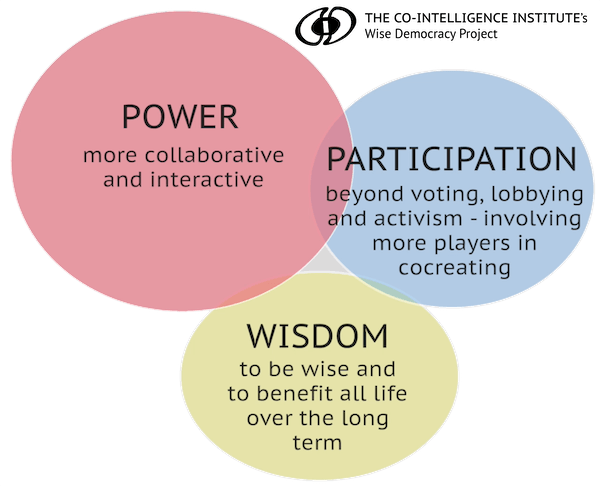
This article lays out how decentralized organizations using systems like sociocracy can be combined with ideas and processes from Wise Democracy.
The reasons that this would be useful are (at least):
- Wise democracy needs sociocracy to answer who decides when all the sense-making and deliberation has been completed. Who stewards a process and holds attention to the continuous listening and improvements needed?
- From the point of view of sociocracy:
- Sociocracy doesn’t have a designated process that includes input from very large stakeholder groups (like hearing the input from 1000 donors or users) beyond representing them in “Stakeholder Circles”.
- This combination is better at spelling out how circles can improve their effectiveness. A sociocratic circle, by default, is encouraged to get feedback and input from stakeholders of their domain when making decisions. Yet, that process of “every circle gets feedback on the effectiveness of their work” requires some guidance, especially in large organizations.
- In short: Wise Democracy tools serve deliberation and input, sociocracy serves decision-making and implementation.
This article has been inspired by Wise Democracy, Dynamic Facilitation, platform coops, my work in Extinction Rebellion, my interest in Exponential Organizations bioregional organizing, network governance, and countless conversations with, to name just a few, Tom Atlee, Liz Barry, Rosa Zubizaretta, Paul Cereghino, Paul Atkins, conversations with various platform coops and organized movements. This article is a further development from my articles on platform coop governance and Could Sociocracy Be Used For A Country? I also presented my “numbers problem”. It also leans heavily on the three phases in generating a proposal in sociocracy: (1) understanding the needs at play and writing a needs statement, (2) picture forming and proposal shaping and (3) synthesizing the proposal. A big puzzle piece came from Tom Atlee who told me about the shift from representing to representing perspectives! Gratitude!
Assumptions made
I am making a set of assumptions – those are clear to me but I want to name them to be transparent and hopefully help follow my reasoning.
- The difference between sociocracy and democracy is that sociocracy is decision-making by those who associate together (workers), while democracy is decision-making by the masses. The default decision-making methods are consent by all circle members in sociocracy, and majority vote by all constituents in democracy.
- Majority vote as a method of decision making needs to be avoided at all costs. Majority rule as a part of democracy polarizes opinions, rewards superficial, populist opinions, and drowns out minority voices.
- Having a voice is more important than having a vote. (With appropriate measures of accountability.)
- Small groups are better than large groups because they allow for deliberation and listening, in particular to hear the nuances and build connection on a personal, human scale.
- In a world as complex and ever-changing (VUCA) as ours, no one individual or group can make decisions that are wise because they lack the insight and information from other perspectives. Therefore, none of their decisions can be sustainable. The more a decision rests on a better representation of our complex realities, the more viable that decision becomes, therefore providing sustainable solutions. Since things change over time, continuous improvement is a key factor in sustainable development over time.
Process: How to combine listening at scale with sociocracy
(The phrase “Listening at scale” was coined by Audrey Tang, Taiwan’s Digital Minister.)
In the following sections, I will go over the different phases in the below diagram, “wrapping” a process given to me by Tom Atlee into a sociocratic context. So let’s assume an organization that operates sociocratically.
That means circles are responsible for decisions in their domain, in a decentralized manner. For example, Membership A is in charge of membership matters (and the final decision-maker in that domain), Twitter Circle is responsible for Twitter (and the final decision-maker on everything Twitter). These decisions are made by consent.
(The initial decision of what circle is in charge of what is made by the founding circle, founders or previous decision-makers. See my book Who Decides Who Decides on how to do it cleanly!)
Any circle is connected in its network in a system of nested domains. That means that each circle is in itself embedded in a network of perspectives, aligning with the domains. For example, Twitter Circle is part of Social Media circle which is part of Communications. That means that each circle will have its very specific support system right around them.
The following table summarizes what will be described in the article.
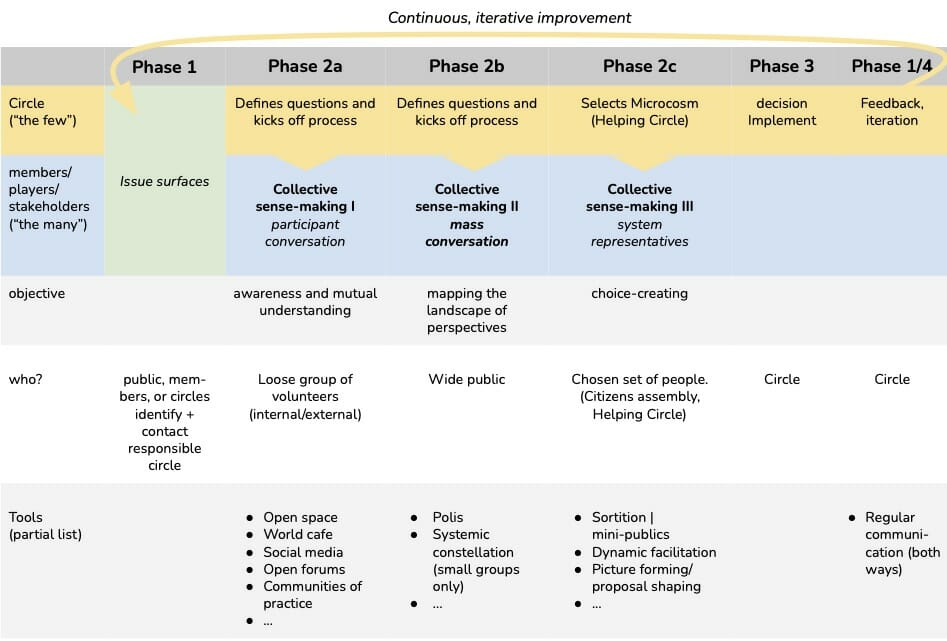
Phase 1: The question/tension surfaces
The process gets kicked off when a tension surfaces. A tension can be an issue or an unresolved question. Ultimately, every open tension is often, at its core, a situation that isn’t understood deeply enough, or requires the capacity of holding two inconsistent truths. Once more people understand more and acknowledge each other’s realities, they will be more likely to choose an action that will satisfying as many needs as possible.
Whatever the trigger or the issue, likely its causes are deep and complex. The decision on whether a tension is a systemic issue or something that can be dealt with circle-internally. The decision on how much feedback/input to solicit and from how many people lies in the circle. The circle maybe choose to:
- engage in deliberation internally to the circle
- ask a select number of people for input (advice process), could be individuals, small/large groups using Dynamic Facilitation, internally or externally
- Kick off a deep process as outlined below
- use sub-sets of the deep process, especially during iterations
How “big” of a process should be chosen? The considerations here are, of course, importance, budget, the bandwidth of the circle, the wickedness of the problem at hand.
Of course, this begs a question: what if an issue is brought up repeatedly that is willfully ignored by a circle whose domain it is in? In that case, stakeholders who are most affected or driven can bring the process to the next-higher circle.
The power of the circle comes with the responsibility to make decisions that work and benefit the whole of the organization. Their interest in serving their aim will depend on their willingness to make sustainable, multi-partial, and therefore realistic decisions.
Phase 2: Sense-making
During this phase, we go through several rounds of sense-making. We explore the issue more deeply, hear each other’s perspectives and realities.
Phase 2a: Talk, talk, talk!
In this first phase, a lot of people talk loosely about an issue. On the smallest scale, a group of people just talks (in rounds, or in “debate” format). On a medium to a larger scale, people can talk in synchronous events like large Open Space gatherings, or they can “talk” in asynchronous ways on forums, chats, social media.
In a way, every interaction with a stakeholder is a sensing and sense-making process but this process is more intentional and focused on a particular question or issue.
This process may or may not have a particular audience to sense into the larger picture that we’re all part of and create conditions for more inclusive possibilities to emerge among us. Most likely, people who feel close to the issue or the organization will engage. If there are people affected who wouldn’t be reached by the process, this needs to be kept in mind. For example, if a network that is very present in affluent communities asks all their connections for input, it’s likely that the perspectives of the people who would join the organization but can’t for lack of resources are left out.
Phase 2b: The landscape of perspectives
In phase 2b, we map the perspectives in the situation. This is an important shift. Instead of mapping the people (weighed by “strength” in numbers), we map the perspectives or functions. Each system will have its own image of complex relationships between perspectives, like a snap shot fingerprint.
Note that the result here is clusters of perspectives, not stakeholders. While there might be some alignment with interests, not all members of a stakeholder group, for example, donors or users, think the same or have the same perspective.
How does one do this? On a smaller scale, constellations come to mind as a tool to observe the different perspectives in a system. On a larger scale, AI-driven tools like Pol.is have been used. Pol.is is a “participatory polling” tool that clusters opinions and surfaces patterns and highly agreeable statements. It’s important to note that Pol.is does not “ignore” or “water down” dissenting voices.
Phase 2c: The microcosm
In the next step, those perspectives and choices need to be distilled into action. Our choices here will depend on the map of perspectives but also on our value system and purpose, as well as our stakeholder voices.
This step requires deliberation and exploration that can best be done by a small facilitated group of people. The smaller the group, the better the listening and the more potent process and facilitation resource investment can be. The larger the group, the more perspectives can be heard and the more diverse people can feel involved. A group size of 5-12 people seems best to give us the best of both worlds. This group of people will generate ideas for action to address the issue at hand.
Who decides who is in the room? That’s not trivial. Possible tools are sortition-based and stratified groups like Citizen Assemblies or Wisdom Councils as well as Helping Circles (temporary circles) with the group members selected by the circle holding the issue.
To enrich the process, I personally would advocate having people in the room also who are responsible for implementing the changes (circle members of the respective circle). This serves two purposes: (1) the circle members(s) get more depth of knowledge on what the reasons are for some positions held. (2) people in the room can do a “reality” check. For example, if there are two equally good strategies and the circle member can speak to one being much easier to implement on a practical level, then this would enrich the conversation.
Processes that can be used here are Dynamic Facilitation and/or picture forming and proposal shaping from the sociocratic toolbox.
Note that those processes are not decision-making processes but only aim to create proposal ideas (or a synthesized form of proposal ideas).
Phase 3: Action!
How can those ideas turn into action? That’s what happens in phase 3. In a sociocratic system, those who are implementing the possible changes need to consent to the proposal. In my experience, they will be grateful to have a well-thought-through set of proposal ideas to turn them into something implementable. This is where the wisdom of the workers comes in. For example, we might all have the opinion that tax incentives for regenerative energies should be increased but which of us can sit down and write those policies up? In a simpler example of a Social Media Circle, if a collective process surfaced that more messaging should happen in a particular way, it’s still the people writing those messages that will need to create the workflows and concrete policies that make it happen and that make it fit into the existing system that outsiders might have no expertise on. If we micromanage or tie the hands of those who need to carry out the decision, we risk incoherent implementations that would ultimately serve no one.
This can clearly be a point of tension. What if the circle that’s in charge ignores the results of the process? That’s why it’s important to be clear about who has the ultimate power. While it seems likely that a decision-making body can’t afford to ignore the results, it’s still possible and agreements need to be made before engaging in the overall process that make it likely that implementation can actually happen. (For Polis in Taiwan, it seems that decisions aren’t binding but there are some extra rules: “Although petitions on Join still aren’t legally binding, any government agency that agrees to participate in a deliberation must, if the petition gets more than 5,000 signatures, give a point-by-point response explaining why it agreed to or rejected the proposal.” Source
Phase 4: Rinse, repeat!
No solution will ever be perfect. Over time, we learn new things, including unintended consequences, and our circumstances will likely change as well. In order to be sustainable, we have to adapt.
Improvement through feedback is part of sociocracy – any policy will only be in effect for a certain term and then gets revisited. That way, we can adapt.
The effectiveness of any policy needs to get a reality check ongoingly. Usually, a circle will have received input from the process that covers a wide range and will be able to adjust accordingly. Yet, if too many things change, it might be time to re-run the process.
A fully sociocratic organization will have a Mission Circle that, by design, already includes the voices of different stakeholders. That way, there’s at least some basic presence and oversight by stakeholder voices, even outside of an acute issue. That said, stakeholders can change issue by issue – for example, sometimes age can be a key factor for someone’s perspective, while other times it might matter more whether someone lives in a city or a rural setting.
Examples
What does this process look like on different levels? See here some fictional examples from a wide range of organizations.
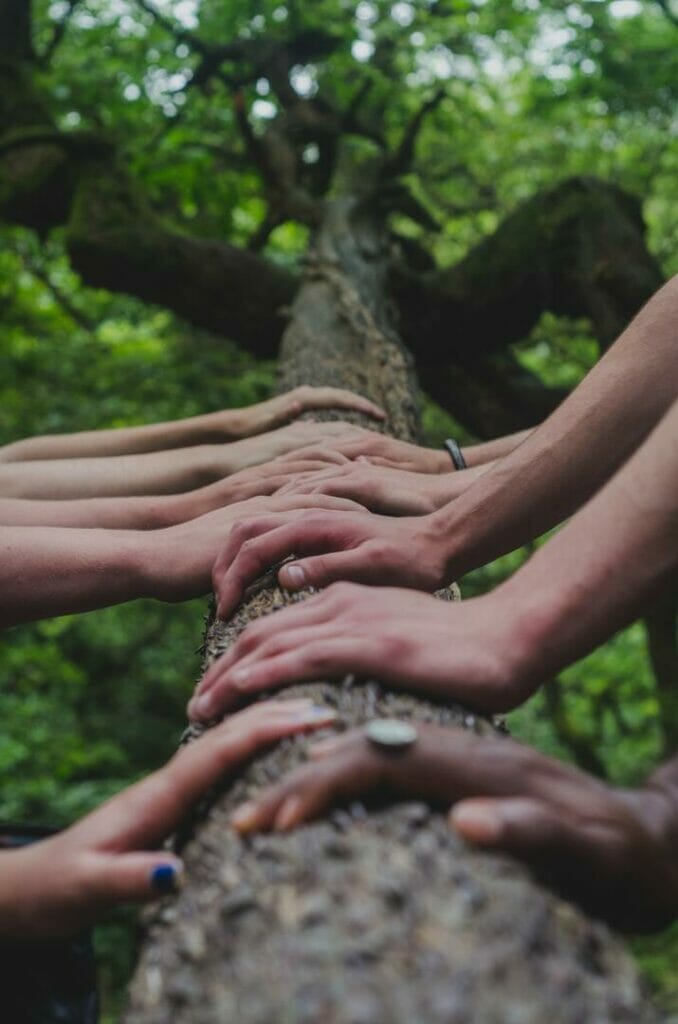
Example: A living community of 80 people, using sociocracy
- Phase 1: An upset set of people raises a question and demands that it be looked at in more depth and with wide community. They identify the circle most likely to be holding the conversation.
- Phase 2a: They organize an open conversation where people talk after a shared dinner.
- Phase 2b: They use spectrum exercises and a constellation process to show the different perspectives and interests on the issue.
- Phase 2c: Given those perspectives, the circle holding the domain selects a Helping Circle of 5 people who will make a proposal. After deliberation, the Helping Circle delivers a proposal to the circle.
- Phase 3: With slight changes for practicability, the circle adopts the proposal.
- Phase 4: The circle plugs the new policy into its standard review process at the end of its term.
Example: a membership organization (nonprofit, or a platform coop or a political party or group of activists)
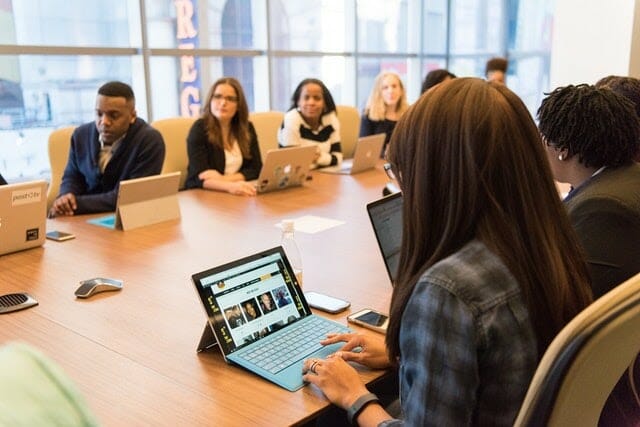
- Phase 1: An upset set of people raises a question and demands that it be looked at in more depth and with wide community. They identify the circle most likely to be holding the conversation.
- Phase 2a: They discuss the questions on a forum on their member page and invite others to join them.
- Phase 2b: They poll their members using polis to harvest the set of opinions.
- Phase 2c: Given those perspectives, the circle uses a special joined meeting of the circle and their Mission Circle, including two extra guests that add to the picture, to make a policy recommendation.
- Phase 3: With slight changes for practicability, the circle adopts the proposal.
- Phase 4: the Mission Circle checks in periodically with the circle to check on the effectiveness of the measures. After 2 years, there is a review process; the circle asks for feedback at a large member gathering and works the feedback into the revised policy.
Example: a bioregion
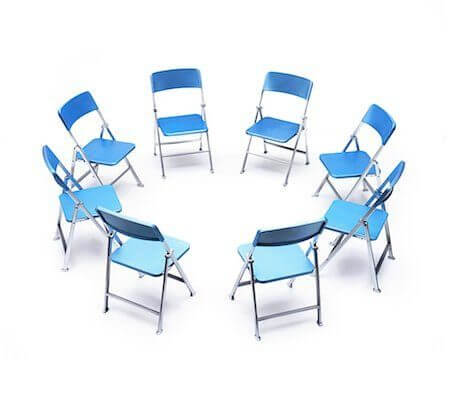
- Phase 1: An upset set of people raises a question and demands that it be looked at in more depth and with wide community. They identify the circle most likely to be holding the conversation.
- Phase 2a: They discuss on their discussion platform and make sure to solicit input from many more people in the bioregion. They then invite people to a large Open Space or a World Cafe weekend to talk more.
- Phase 2b: They poll their members using polis to harvest the set of opinions.
- Phase 2c: They form a sortition-based group of randomly selected people, a council, who use Dynamic Facilitation to have a choice-creating conversation and come to possible solutions.
- Phase 3: The council submit their best ideas to the circle. The circle synthesizes the ideas into a proposal and adopts it.
- Phase 4: The circle runs a survey that measures satisfaction with the new policy in the bioregion. After 1 year, they run a 1-day workshop, with special invitation to everyone who has contributed in the past, as well as new members. A report is made public to everyone.

